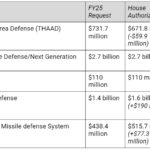Table numbers in parentheses are increases or decreases from the FY24 Request FY25 requested levels come from the Center for Arms Control and Non-Proliferation’s Fiscal Year 2025 Defense Budget Request Briefing Book Numbers may not add due to rounding Total National Defense Discretionary Spending Request (050) DOD Nuclear Weapons Funding Request for Select Programs National […]
Nuclear Weapons
Op-ed: Why Congress Shouldn’t Fund a New Sea-Launched Nuke
Senior Policy Director John Erath wrote an op-ed in Just Security about the nuclear sea-launched cruise missile (SLCM-N) and why it is not worth its cost. Reviving the nuclear-armed sea-launched cruise missile not only goes against sound military doctrine, it also undermines the basic national interests the United States Navy has always protected. So why do […]
We Now Know the Full Extent of the U.S. Nuclear Arsenal
Executive Director John Tierney spoke with The Progressive Magazine on the importance of transparency in nuclear dialogue. Defense hawks, including former President Donald Trump, argue that releasing stockpile details gives enemies vital information. But advocates say otherwise. Transparency “reduces chances of misperception and removes another’s perceived need to build more under an impression that it is ‘behind’ […]
Summary: Fiscal Year 2025 National Defense Authorization Act (S. 4638) as passed by the Senate Committee on Armed Services
Table numbers in parentheses are increases or decreases from the FY25 Request FY25 requested levels come from the Center for Arms Control and Non-Proliferation’s Fiscal Year 2025 Defense Budget Request Briefing Book Numbers may not add due to rounding Total National Defense Discretionary Spending Request (050) DOD Nuclear Weapons Funding Request for Select Programs National […]
Where Is the Protest?
Executive Director John Tierney spoke with The Progressive Magazine about factors that are impacting the lack of focus on today’s worsening arms race. The end of the Cold War with the 1991 collapse of the Soviet Union and a series of treaties that reduced the number of nuclear warheads worldwide from more than 70,000 to 12,500 today. “I […]


